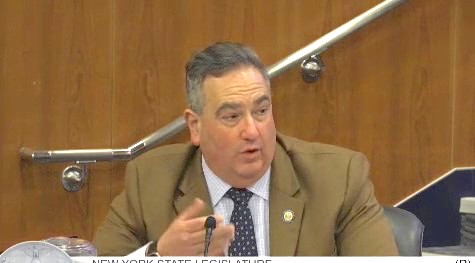Borrello Questions Rural School Aid Cuts

State Sen. George Borrello, R-Sunset Bay, speaks during a joint legislative budget hearing on education in Albany.
There doesn’t seem to be a lot of agreement with Gov. Kathy Hochul’s changes to state aid that have resulted in state aid decrease for four local school districts.
Gov. Kathy Hochul’s 2024-25 state budget proposal includes state aid decreases for four local schools – Chautauqua Lake, Ripley, Pine Valley and Clymer. State Sen. George Borrello, R-Sunset Bay, said in a recent email that half of the districts in his Senate district are proposed to lose state aid under Hochul’s budget proposal.
Several legislators expressed concern with Hochul’s proposed education budget, including Borrello.
“I represent a lot of rural school districts and obviously there has been an enrollment decline,” Borrello said. “Earlier I think you commented on the hold harmless and your concerns about that. If you could expound on that? What I’m hearing from my rural school districts is that their fixed costs aren’t going down with less money – in fact they’re going up. Particularly when you start talking about mandates, Assemblywoman Walsh brought up the electric school bus mandate. That could be a huge hit. If you wouldn’t mind talking a little bit about why this hold harmless shouldn’t somehow be tied to enrollment.”
Betty Rosa, state education commissioner, said in her written testimony before the joint legislative budget committee that Hochul made two significant changes to the foundation aid formula for schools. The first is replacing a single-year inflation value (4.1% for 2023) with a multi-year average of 2.6% to reduce the year-to-year growth in the foundation aid amount by $331.4 million. Multi-year averages are used in several places in foundation aid, and they yield more stable results, but the average used in the executive budget, Rosa said, reduces growth in a year when inflation remains high. Hochul also cut save harmless funding by $167.9 million across 337 districts. Reductions are prorated based on district wealth but occur primarily within rural districts and represent sizable reductions in many districts, especially those that have had the greatest enrollment declines. The proposal does not include a minimum increase for all districts.
“It shouldn’t be tied to the hold harmless, especially without planning in the future that this was coming,” said Dr. Jeffrey Matteson, state Education Department senior deputy commissioner for education policy. “The abrupt nature, I think, is the biggest challenge to the districts. Also I think we know in the last 20 years there are different challenges with students. Coming out of COVID we have more challenges with students in these districts and they’ve used some of their federal money and some of the foundation aid money they’ve received in the last three years to try to add those needs in real time. In many ways those three years of funding made up for a decade worth of withholding money from districts and getting that money without a mechanism for them to set aside to make sure that they had it in perpetuity was a real challenge as well. Hitting their main funding source after they had been made whole in the prior year and made budgetary plans for a long-term future is the biggest challenge for some of these districts.”




